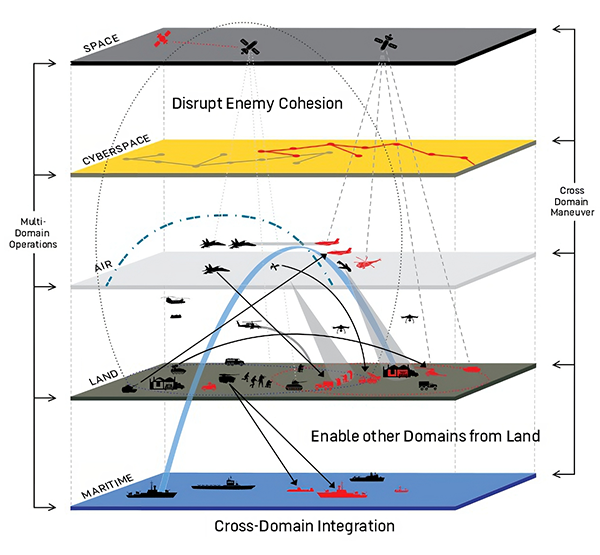Multi-Domain Operations are the combined arms employment of capabilities to create and exploit relative advantages that achieve objectives, defeat enemy forces, and consolidate gains.
Multi Domain Operations (MDO) refers to a military concept that aims to integrate operations across multiple domains, including land, air, sea, space, and cyberspace. The goal of MDO is to create a more efficient and effective way of conducting military operations, leveraging the advantages of each domain to gain a decisive advantage over the enemy.
Key Aspects
One of the key aspects of MDO is the integration of intelligence, surveillance, and reconnaissance (ISR) capabilities across multiple domains. This allows military forces to gather and analyze information from various sources in real-time, enabling them to make more informed decisions and respond to threats more quickly.
Another important aspect of MDO is the integration of weapons systems across multiple domains. For example, a sea-launched missile might be guided by data from an air-borne sensor, or a ground-based drone might be controlled by a command center located in space. This integration allows military forces to use the strengths of each domain to achieve their objectives, whether that be precision strikes, reconnaissance, or the delivery of supplies and personnel.
MDO also requires close coordination between different branches of the military, as well as between military and civilian agencies. This requires effective communication, as well as the development of common operating procedures and technologies.
The central idea is to prevail by competing successfully in all domains short of conflict, thereby deterring a potential enemy. If deterrence fails, the following might be the way forward:
- Penetrate enemy anti-access and area denial (A2/AD) systems (layered and integrated long-range precision-strike systems, littoral anti-ship capabilities, air defenses, and long-range artillery and rocket systems) to enable strategic and operational maneuver
- Dis-integrate—disrupt, degrade, or destroy A2/AD systems to enable operational and tactical maneuver
- Exploit the resulting freedom of maneuver to achieve operational and strategic objectives by defeating enemy forces in all domains.
- Re-compete—consolidate gains across domains and force a return to competition on favorable terms.
The Potential of MDO
Multi Domain Operations (MDO) has the potential to significantly expand the capabilities of command and control (C2) in several ways:
Enhanced situational awareness: By integrating information from multiple domains, MDO provides military commanders with a more comprehensive and accurate picture of the battlefield, allowing them to make informed decisions and respond to threats more quickly.
Decentralized decision-making: MDO allows for more decentralized decision-making, with lower-level commanders able to make decisions based on real-time information and guidance from higher-level commanders. This can lead to faster and more flexible responses to rapidly changing battlefield conditions.
Improved command and control communications: MDO requires the development of new and more robust communication systems that can operate across multiple domains, allowing for better coordination and collaboration between military units.
Increased agility and responsiveness: By integrating capabilities across multiple domains, MDO enables military forces to respond more quickly and effectively to evolving situations. This can give military commanders greater flexibility to respond to rapidly changing conditions, and to take advantage of new opportunities as they arise.
Enhanced integration of civilian and military efforts: MDO also has the potential to better integrate the efforts of military and civilian agencies, such as law enforcement, disaster response organizations, and others. This can lead to more effective and coordinated responses to a wider range of security and humanitarian challenges.
Overall, Multi Domain Operations has the potential to significantly expand the capabilities of command and control by providing military commanders with enhanced situational awareness, more flexible decision-making, improved communications, increased agility and responsiveness, and better integration of civilian and military efforts.
Joint Structure and Combined Operations
Advanced technology is rapidly changing the operating environment. Technology breaks down traditional barriers and extends range: cyberattacks and electronic warfare have physical impact. Previously unchallenged domains, such as air, are now vulnerable to short-range threats from the ground, as well as advanced anti-access/area denial equipment. Multi-domain battle creates opportunity in one domain using the capabilities of others, including nontraditional domains such as cyber and space.
Today, actors like transnational groups and regional powers operate outside traditional borders and in nontraditional domains, which the combatant command structure does not readily accommodate. Effective commands should not be solely regional, but mission-driven, leveraging and coordinating a diversity of capabilities. These new combatant commands would be determined to counter specific current threats. They would mirror today’s commands on the surface but would be unrestrained by the current geographic definitions — allowing commanders to focus on the threat regardless of physical areas of responsibility.
Multi Domain Operations/Battle concept articulates future combined arms operations. In doing so, it prepares forces for the increased jointness required to achieve effects across multiple domains, including new ones such as cyber. Doctrinal innovation also often galvanizes organizational innovation. The philosophical underpinnings of multi-domain battle should be used to design a new combatant command structure.



















